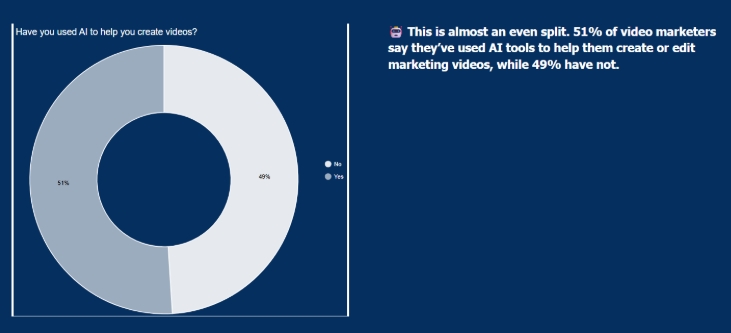The video production landscape is undergoing a transformative shift driven by evolving marketing strategies, artificial intelligence integration, and the critical importance of regional expertise. As consumer behavior continues to fragment across digital platforms and attention spans decrease, marketing directors and CEOs must navigate an increasingly complex content creation ecosystem. This analysis examines how successful video production strategies now require a multifaceted approach that combines cutting-edge marketing techniques with AI-powered tools while leveraging the irreplaceable value of local market knowledge. The convergence of these elements—strategic marketing innovation, technological advancement, and regional specialization—will determine which organizations thrive in the future of video production. For decision-makers seeking sustainable competitive advantage, understanding these interconnected trends is not merely beneficial but essential for long-term success in an industry projected to reach unprecedented growth levels by 2025.
Marketing Strategies: Adapting to the Attention Economy
The modern marketing landscape demands agility and precision, with video content serving as the primary vehicle for brand engagement. Anticipated video marketing trends include greater integration of AI tools for personalized content, immersive experiences through augmented and virtual reality, and increased focus on interactive and shoppable videos, fundamentally reshaping how brands connect with audiences.
Short-Form Content Dominance
Short-form content has emerged as the dominant force in digital marketing, specifically tailored for platforms like TikTok, Instagram Reels, and YouTube Shorts. This shift directly responds to the documented decrease in attention spans among younger demographics, forcing brands to capture viewer interest within the critical first few seconds. The ubiquity of mobile devices and social media access has made this approach not just viable but essential. Research from Wyzowl reveals that 69% of video marketers actively utilize social media videos to reach their target audiences, demonstrating the widespread adoption of this strategy.

*Use cases for video marketing in 2025
The success of short-form content lies in its ability to deliver immediate value while maintaining brand authenticity. AI-generated content is set to revolutionize video creation, allowing brands to produce personalized, high-quality videos at scale, enabling companies to create multiple variations of short-form content efficiently. This technological enhancement allows for rapid testing and optimization of messaging across different audience segments.
User-Generated Content as Brand Amplification
User-generated content (UGC) represents a powerful strategy that transforms consumers into brand advocates. Apple’s “#ShotoniPhone” campaign exemplifies this approach, encouraging customers to showcase their photography skills while simultaneously demonstrating product capabilities. This strategy succeeds because it creates authentic connections between brands and consumers while generating cost-effective marketing content.
UGC campaigns foster community engagement by allowing audiences to participate directly in brand storytelling. The psychological impact of seeing peers endorse products through their own creative expressions often proves more compelling than traditional advertising methods. This approach also provides brands with diverse content perspectives that resonate across different demographic segments.
Visual Storytelling and Emotional Connection
Many brands put visual storytelling to work, thus pushing their video marketing efforts to attract the audience and encourage engagement. Focus on crafting stories that evoke emotion, establishing deeper connections with viewers. Modern consumers increasingly expect authentic narratives that transcend simple product promotion, seeking content that reflects their values and aspirations.
AI Adoption: Revolutionizing Production Workflows
The integration of artificial intelligence in video production has moved beyond experimental phases into mainstream adoption, fundamentally altering industry workflows and capabilities. The global AI video generator market size was estimated at USD 554.9 million in 2023 and is expected to grow at a Compound Annual Growth Rate (CAGR) of 19.9% from 2024 to 2030, indicating massive industry investment and adoption.
Personalization at Scale
Streaming services like Netflix, Hulu, and Max have pioneered AI implementation for content recommendation, creating personalized viewing experiences that increase engagement and retention. This personalization extends beyond content suggestion to include dynamic thumbnails, customized trailers, and targeted promotional materials. The success of these applications demonstrates AI’s potential to enhance user experience while optimizing marketing effectiveness.
Roughly 61% of video production teams adopt AI-based content recommendation systems to guide content creation decisions, showing widespread industry acceptance of AI-driven insights for strategic planning.
Production Efficiency and Cost Reduction
AI tools are revolutionizing content creation through automated script generation, art creation, and music composition. Platforms like ChatGPT, Gemini, and Kapwig streamline production workflows, significantly reducing time-to-market and operational costs. Wyzowl’s research indicates that 51% of video marketers have utilized AI for creating or editing marketing videos, demonstrating rapid adoption across the industry.

*Percentage of video marketers utilizing AI tools
AI in the video editing market is estimated to reach USD 4.4 billion by 2033, Riding on a Strong 17.2% CAGR throughout the forecast period, highlighting the substantial economic impact of these tools.
Leading AI Tools Transforming Production
Five prominent AI tools reshaping video production capabilities:
- Veed.io provides comprehensive editing solutions including background removal, format adaptation, and multi-platform optimization
- ElevenLabs specializes in multi-language translation and AI dubbing, enabling global content distribution
- InVideo AI offers intelligent templates and automated editing workflows
- Descript combines screen recording, audio editing, and multi-language transcription capabilities
- Synthesia delivers customizable AI avatars with multi-language support and integrated editing tools
These platforms collectively address the full spectrum of production needs while maintaining professional quality standards.
The Value of Regional Expertise: Local Knowledge as Competitive Advantage
While AI adoption accelerates globally, regional expertise remains irreplaceable for successful video production campaigns. With 31.40% of the global revenue share in 2024, Asia-Pacific leads the AI video generator market. This dominance is attributed to its extensive customer base and the widespread adoption of AI video generator software across industries like marketing, education, and entertainment, demonstrating how regional factors influence technology adoption patterns.

*AI Video Generator Market Size & Trends
AI Integration in Local Markets
Regional companies are strategically implementing AI tools to enhance their competitive position against larger national firms. AI-powered customer profiling helps local businesses understand community needs more precisely, informing project delivery strategies and content development. Research indicates that organizational effectiveness, business structure, and technology systems all benefit from AI integration, enabling smaller companies to compete more effectively with larger competitors.
Navigating Regulatory Complexities
Local production companies possess intimate knowledge of regional regulations, permits, and compliance requirements that can significantly impact project timelines and costs. For instance, street closure requirements vary dramatically between cities: San Diego requires filming registration forms submitted at least five business days prior to shooting, while Los Angeles requires only three business days’ notice. This regulatory familiarity prevents costly delays and ensures smooth production workflows.
Understanding local customs, cultural sensitivities, and community dynamics further enhances production value while minimizing potential conflicts or misunderstandings during filming.
Established Vendor Networks and Cost Efficiency
Regional production companies maintain long-standing relationships with local equipment suppliers, location owners, and service providers. These established networks often result in preferential pricing, priority access to resources, and enhanced reliability during critical production phases. Many local companies also own studio facilities, eliminating rental costs while providing greater scheduling flexibility.
These relationships extend beyond mere cost savings to include collaborative problem-solving, emergency support, and creative input that enhances final production quality.
Cultural Insight and Audience Understanding
Local production companies possess a deep understanding of their target demographics, enabling more effective messaging and creative approaches. TriVision Studio’s success across different markets illustrates this principle: their Washington D.C. work focuses on policy advocacy and corporate communication for government officials and policymakers, while their Los Angeles projects emphasize creativity and innovation to stand out in the entertainment capital’s competitive landscape.
This cultural fluency extends to language nuances, visual preferences, social dynamics, and consumption patterns that significantly impact campaign effectiveness.
The Future of Video Production: Market Projections and Strategic Implications
The video production industry faces unprecedented growth opportunities driven by streaming service expansion, AI technology advancement, and evolving consumer preferences. Understanding these trends enables strategic planning and investment decisions that position companies for long-term success.
Streaming Service Market Dominance
Content spending patterns reveal significant shifts in industry dynamics. Streaming services are projected to account for 39% of global content spending in 2025, representing a 6% increase over four years and surpassing traditional commercial broadcasting. This growth trajectory continues despite the end of pandemic-driven viewing spikes, indicating sustainable demand for streaming content.
*Distribution of video content spending worldwide from 2021 to 2025, by company type
Personalized recommendations held a significant 32.9% market share in 2024, reflecting consumer demand for tailored experiences on platforms like Netflix and Spotify, emphasizing the importance of AI-driven personalization in content strategy.
Technology Integration and Market Expansion
In 2024, the market stood at USD 614.8 million. At what CAGR is the market projected to grow during the forecast period of 2025-2032? The market is projected to record a CAGR of 20.0% during the forecast period of 2025-2032, indicating substantial investment opportunities and market expansion potential.
The convergence of AI capabilities, improved internet infrastructure, and changing consumer behaviors creates favorable conditions for innovative production companies. Organizations that successfully integrate these technological advances while maintaining creative excellence will capture disproportionate market share.
Emerging Trends and Strategic Opportunities
Several key trends will shape the industry’s future trajectory:
Interactive and Shoppable Video Content: Integration of e-commerce functionality directly within video experiences, enabling immediate purchase decisions without platform switching.
Immersive Technologies: Virtual and augmented reality applications that create engaging, memorable brand experiences while differentiating companies from competitors.
Voice Search Optimization: Content designed specifically for voice-activated discovery and consumption patterns.
Sustainable Production Practices: Environmental consciousness driving demand for eco-friendly production methods and carbon-neutral content creation.
Conclusion
The video production industry stands at a critical inflection point where traditional approaches must evolve to incorporate technological innovation while preserving the irreplaceable value of human creativity and regional expertise. Marketing directors and CEOs who recognize this complexity and act strategically will position their organizations for sustained success in an increasingly competitive landscape.
The convergence of sophisticated marketing strategies, AI-powered production tools, and deep regional knowledge creates unprecedented opportunities for companies willing to invest in comprehensive capabilities. Short-form content dominance, user-generated campaigns, and personalized experiences represent more than tactical shifts—they reflect fundamental changes in how audiences consume and engage with video content.
AI adoption is no longer optional but essential for maintaining competitive parity. However, technology alone cannot replace the cultural insight, regulatory knowledge, and community connections that regional production companies provide. The most successful organizations will integrate AI efficiency with local expertise, creating hybrid approaches that deliver both operational excellence and authentic audience connection.
Looking forward, the industry’s projected growth trajectory—with AI video generation markets expanding at 19.9% annually and streaming services commanding increasing content budgets—validates the strategic importance of video production investments. Companies that develop integrated capabilities across marketing strategy, technology adoption, and regional expertise will capture disproportionate value as the market continues expanding.
The future belongs to production partners who demonstrate consistent innovation while maintaining deep market understanding, technological proficiency, and creative excellence. For decision-makers evaluating video production strategies, the question is not whether to invest in these capabilities, but how quickly they can build comprehensive competencies that position their organizations at the forefront of this transformative industry evolution.
Success in this environment requires more than keeping pace with trends—it demands anticipating future developments while executing flawlessly in the present. The organizations that master this balance will not merely survive the industry’s transformation but will define its future direction.
References
- Wyzowl. (2024). Video Marketing Statistics 2025 (11 Years of Data)
- Marathe, S., & Kanage, P. (2024). Decrease in attention span due to short format content on Social Media
- Meltwater. (2024). 16 Examples of Excellent UGC
- ElevenLabs. (2024). The top 5 AI-driven tools to enhance video production
- Horvat, M., & Schultman, J. (2024). Exploring the factors driving AI adoption in production: a systematic literature review and future research agenda. Information Technology and Management
- Adeyemi, A. (2024). Technology That Can Support More Locally Focused Production
- San Diego Film Commission. (2024). San Diego Filming Production Guide
- Los Angeles Film Commission. (2024). Los Angeles Filming Production Guide
- Visual Captive Video Production. (2024). The Advantages of Hiring a Local Video Production Company
- TriVision Studio. (2024). How Regional Differences Impact the Video Production Industry
- Stoll, J. (2025). Global video content spend by company type 2025. Statista
- Grand View Research. (2024). AI Video Generator Market Size And Share Report, 2030
- Market.us. (2024). AI in Video Editing Market Size, Share, Growth
- Fortune Business Insights. (2024). AI Video Generator Market Size, Share | Growth Report [2032]
- Zebracat. (2025). 150+ AI-Generated Video Creation Statistics for 2025
- ArtSmart AI. (2025). 13 Statistics of AI in Media and Entertainment in 2025
- Vidico. (2025). 20 Video Marketing Trends You Need To Watch Out For (2025)




